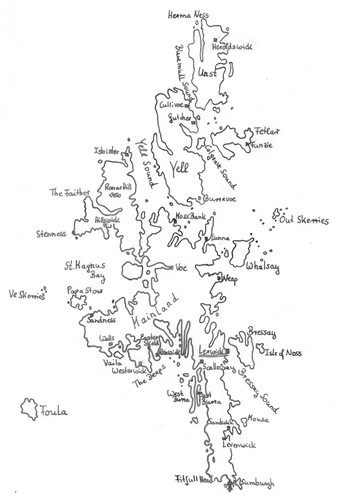| The Kennel The Shetland Collie |
The Field, The Country Gentleman's Newspaper, 21.02.1903 |
One of my earliest archive "snippets" relating to the Shetland Sheepdog dates from 1903. Unfortunately, the bitch mentioned and pictured in the text can only be recognised as a black spot.
The Field, The Country Gentleman's Newspaper, 21.02.1903, Page 299:
"THE KENNEL
----------
THE SHETLAND COLLIE.
At one of the shows for toy dogs which was held at Westminster Aquarium in October last a peculiar bright brown or red coloured dog was shown which caused some little interest. About the size of a fox terrier, it was described as a Shetland collie, and although it bore certain characteristics of that variety, an ordinary observer would scarcely have recognized it as a variety of our fashionable sheepdog. Feeling somewhat interested in the little animal, we caused inquiries to be made in the Shetland Isles, with the result embodied in the following article, written, we may say, by a resident in Lerwick, who had every opportunity of gaining the information required. He found many of the natives who possessed the real type of dog indigenous of the islands, averse to granting permission for them to be photographed, but he was able to obtain three different pictures, the best of which we reproduce. This is a bitch named Fanny, about 5 years old, and 17 lb. in weight. She is the property of Mr. John Leask, Victoria Wharf, Lerwick. From a later communication we learn that a person in Lerwick, breeding these dogs for the market, has recently sold several to people in the south of England; he aims to produce them as small as possible, and usually below the average size. Our correspondent writes:
'Is there such a breed of dogs as the Shetland collie? Nine out of every ten persons, even in Shetland itself, if asked the question, would reply that they did not know. A Shetland pony is readily recognized all the world over. The Sheltie is a distinctive variety by itself; in semiwild state, with unkempt coat, shaggy mane, and diminutive size, it is at once proclaimed unique. But the Shetland collie hat not so many peculiarities differentiating it from the ordinary run of the canine race, nor has it gained the same world-wide celebrity as the pony of the islands, hence it has not hitherto attracted much attention on the part of dog fanciers. That there is in Shetland a dog possessing certain peculiarities which would seems to warrant its being regarded as a distinct variety is undoubted, for in various parts of the islands, in widely different parts of the country, specimens so identical in their various points are found as to warrant the assertion that they form a distinctive breed peculiar to the islands.
The most common type met with is a little dog weighting about 15lb. or 16lb. It has a slight shaggy coat, which is not so soft as that of a Pomeranian nor so coarse as that of a terrier; it is in texture something between these two. The paws and lower half of the forelegs are generally white, as are also the breast and muzzle. The rest of the body, except the hind paws and tip of the tail, is black. In some specimens the white of the fore part extends as far back as about the middle of the body, which gives the animal a peculiar appearance - something the same as though it were wearing a jacket. This description, as has been said, applies to the most common type to be met with. Generally speaking, these dogs bear some resemblance to the Esquimaux dog, only the tail is different and the ears are larger. But there appear to be several families of the Shetland collie, the variation in colour being the most pronounced. Some are black and tan while others are jet black. Such as are of the latter colour are particularly pretty dogs. The face is very sharp, the legs are thin, and the body not so heavy as in the black and white variety. The black and black and tan variety in some respects resemble the Prince Charles spaniel, but of course longer in face.
The Shetland collie, if the name is allowable, has nothing of the characteristics of the Scotch collie. It is not a sheepdog. At least it is rarely, if ever, used for that purpose. It is said to be very docile and easily trained, but it is much too small to be of any use for service with the shepherds. Most of the crofters have sheepdogs, but these are more skin to the Scotch collie both in size and characteristics. They are in fact Scotch collies, though showing more or less variation from the true type, being generally crosses with collies owned by the shepherds of the large farmers. The small Shetland collie is what is known as a "toun" dog - that is, it is really a house dog. In the Shetland country districts every croft, or collection of crofts, is called a "toun", and no place of the kind is without its dog, whether for use or ornament.
The parishes of Delting and Northmavine are the places where the Shetland collie is most numerous. They mostly disappear in districts where larger dogs are required for sheep driving purposes, and they are usually kept as pets. They are of an affectionate disposition, very readily make friends, and a good specimen of the breed is an exceedingly pretty little animal.' "
If you discover any errors in the text that may have been caused by the transcription, please let us know for a prompt correction.

